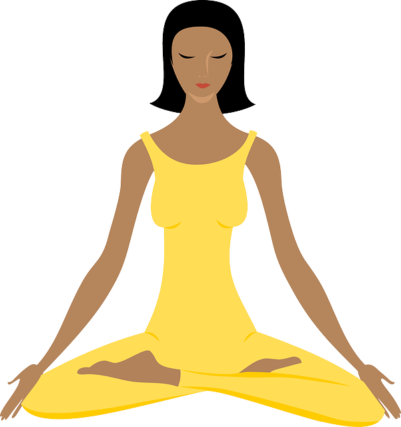Often when we come across images of meditation, we see people who are sitting with legs crossed in a full lotus position. They look so comfortable, and serene, and it makes sitting cross-legged look so easy….
However, for westerners who are used to sitting in chairs most of the time, it is far from easy! And even if we can manage to bend ourselves to sitting cross-legged, it is usually not at all comfortable.
So, is your meditation practice going to be adversely affected if you sit without crossing your legs?
Let’s explore this question in more detail.
Can You Meditate Without Crossing Your Legs?
Yes, meditation can be done without crossing your legs. While there are some physical and energetic benefits to meditating in specific postures, including crossing your legs, a ‘correct’ posture is not the main purpose for practicing meditation. Meditation is all about achieving a particular ‘state of mind’ that aligns with our goals. And with practice, we can learn to achieve this alignment in almost any position, at any time, and in any place.
Posture Is An Important Aspect Of Learning To Meditate. However, You Can Meditate Without Crossing Your Legs.
When learning to meditate, our posture can be used as one of our focal points to help us build discipline, structure, and regularity in our practice. By choosing to sit, stand, lie, (or another), in a particular position, at a particular time each day, we are sending signals to our body and mind that ‘I am now here to meditate.’
Becoming comfortable in any position for an extended period can be challenging. It’s also something new for many of us. These days, our lives tend to be packed with over-stimulation a lot of the time. We are so busy reacting to stuff in our environment that we may not even know what our own basic thought patterns and ‘base physical state’ are like when we have nothing to distract us.
However, if we practice regularly, our bodies and minds will come to accept that ‘this is the time for meditation.’ and they will slowly begin to release resistance. This means that we will more easily, consciously and unconsciously, ‘allow’ a deeper meditative state to happen for us.
 Initially, we may begin to notice thoughts, feelings, and sensations that maybe we have not experienced before. Our posture may prompt various sensations including vibrations, tingling, vertigo, feelings of expansion/contraction, heat or coolness, twitching, and of course, the inevitable aches and pains.
Initially, we may begin to notice thoughts, feelings, and sensations that maybe we have not experienced before. Our posture may prompt various sensations including vibrations, tingling, vertigo, feelings of expansion/contraction, heat or coolness, twitching, and of course, the inevitable aches and pains.
And depending on our goals for meditating, we may ‘actively notice’ these experiences without attachment, or simply attempt to return our minds back to our mantra or affirmation once we become aware that ‘we are aware’ that our mind has wandered.
Our Posture Reveals Much About Us.
Meditation also has a way of revealing weaknesses inherent within us. It may be our inability to focus for longer periods of time, or weaknesses in our physical structure. Our posture may reveal tension in our spine, an imbalance in our hip flexibility, or a misalignment of the vertebrae in our necks. However, all things can be sorted out with time and practice.
 Through meditation, we may first become aware of these issues and then, fortunately, meditation also provides us with ways to resolve them. Learning to accept our ‘weaknesses’ is an important first step to non-judgmental allowing. And with time and practice, we will find that the wisdom within our body’s cells will naturally align us with well-being.
Through meditation, we may first become aware of these issues and then, fortunately, meditation also provides us with ways to resolve them. Learning to accept our ‘weaknesses’ is an important first step to non-judgmental allowing. And with time and practice, we will find that the wisdom within our body’s cells will naturally align us with well-being.
All ‘issues’ will naturally correct themselves as we build trust in the process of life that meditation gives us when we are not bowing down to external distractions. The inherent intelligence in our bodies and minds actually knows what is best for us. However, we seem to have been our own worse enemy for many years already…… as it is our learned conditioned reactions to life that are most often the reasons we are stiff, inflexible, and unwell!
Will Sitting With Crossed Legs Ever Become Easier?
Many peoples in the world grow up sitting on the floor in cross-legged positions. For them, it is completely natural. So their hips are open and flexible throughout their lives…. so it’s no problem for them to sit for long periods in advanced meditation postures.
However, it’s not the same for many of us who grew up sitting on furniture most of the time. For us, when beginning a meditation practice, it is important to try and be at ease as much as possible with our posture.
Why? Because if you are sitting in pain for the duration of your session, and all you can think about is the pain, the time spent meditating is of no value to you. And if you’re not benefiting from your practice, it’s more than likely that you will give up after a short time.
So, initially when you begin a meditation practice, choose a posture that you can remain in, in relative comfort, for the duration of your session. By doing so, you are more likely to practice more frequently.
And once your ability to focus your mind and accept some discomfort increases, you can begin working towards more challenging postures. You may even want to build up to being able to sit in the full lotus position. (It took me many years to be able to sit in Lotus comfortably for 20 minutes.)
 To make it easier to sit, you could practice some yoga poses before meditating. Yoga and meditation go hand in hand as practices that complement each other….. and many yoga postures will warm up, and create space in, your joints to enable sitting with crossed legs easier.
To make it easier to sit, you could practice some yoga poses before meditating. Yoga and meditation go hand in hand as practices that complement each other….. and many yoga postures will warm up, and create space in, your joints to enable sitting with crossed legs easier.
You can also use props such as yoga blocks, meditation cushions, meditation chairs, etc. to make your session more comfortable. And over time, you could reduce the size of the props as your body becomes more flexible and used to sitting for longer times.
You may like to read about my experience with the unexpected spontaneous release of pain in my post: How Can I Meditate For A Longer Period Of time?
Creating A Practice That Works For You Is Key To A Beneficial Meditating Practice.
Meditation, like most things in life, is better when you are committed to it. Becoming committed requires that you believe you will benefit from the practice. And selecting a posture that is comfortable for you from the beginning will make it easier to relax into and benefit from your sessions.
There is no such thing as a bad meditator…. However, there are a lot of people who give up too easily…. and many others who benefit less from their practice than they could. Why, because some of them try to copy the pictures they see of how meditation should be done!
And while beautiful, the pictures showing people with amazing postures is not how many advanced meditators do it…….
There are so many valid meditation techniques and positions that benefit a wide variety of people. Therefore, it is impossible that you won’t find a posture to suit you while you are building up to being able to sit in the full lotus position. And if you do any of them consistently, you will benefit from your sessions.
And with time, you can modify and adjust your postures as well as your desired outcomes as you evolve and your life circumstances change.




